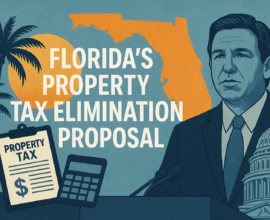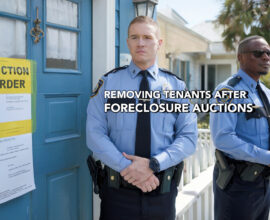Will Trumps Tariffs and 2025’s Economic Shake-Ups Hit the Real Estate Market?
Will Tariffs and 2025’s Economic Shake-Ups Hit the Real Estate Market?
In a year already defined by global friction, supply chain headaches, and cautious lending, 2025 may be a make-or-break moment for real estate investors—especially those working in Florida’s foreclosure and auction markets. With a new wave of tariffs rolling out, builders, flippers, and even cash buyers are starting to ask the same question: how much of this is noise, and how much of it is going to cut into my bottom line?
Let’s break it down: how the current economic climate—and in particular, new tariffs—might affect the Florida real estate market, who stands to benefit, and where savvy investors should shift their strategies.
The Global Ripple Hitting Local Real Estate
Tariffs may sound like something that only affects big corporations or international trade deals. Still in reality, they directly influence the price of building homes and fixing up properties right here in Florida.
Real estate developers are already feeling the 2025 tariff increases on steel, aluminum, electronics, and other materials from China and other nations. From rebar and drywall to HVAC parts and electrical components, costs are climbing—and these increases are passed on to investors and buyers.
According to Reuters, the Biden administration’s 2025 tariffs could raise construction material costs by billions of dollars, and many builders say those increases are already showing up in bids and supply orders.
These added expenses matter in Florida’s tight-margin markets, where a few thousand dollars can make or break a deal. Delays in shipping and fluctuating prices make it harder to estimate project costs, slowing down new construction and complicating flips.
Even cities are feeling the heat. Some municipalities are hesitating on project approvals due to budget uncertainties, putting a damper on regional growth.
How Tariffs Drive Up Housing Costs—One Load of Steel at a Time
Ask any Florida investor actively working on renovations, and they’ll tell you that materials are pricier and harder to get than they used to be.
According to National Association of Home Builders data, prices for imported construction inputs like copper wiring, HVAC systems, and even tile have risen over 10% in the past year.
A 3-bedroom foreclosure in Broward County was recently sold for $232,000 at an auction. It looked like a solid deal—until the investor priced out a new roof and HVAC system. With the cost of copper wire, ducts, and aluminum coils climbing fast due to tariffs, the renovation budget shot up by over $22,000.
Multiply that budget jump across five or ten projects, and it becomes clear why some investors are holding back. Others are trying to complete smaller-scale rehabs that require fewer imported components.
To make matters worse, many contractors are baking future price increases into their bids. Investors who fail to lock in a firm scope of work early are getting hit with change orders and longer timelines.
High Rates, High Costs—The New Normal for Borrowers
As material costs rise, so do borrowing costs. According to recent Freddie Mac surveys, mortgage rates are stuck in the mid-to-high 6% range , hovering between 6.6% and 6.8% in early April 2025.
The Federal Reserve’s ongoing rate strategy aims to cool inflation but has made mortgages less affordable and homebuyers more cautious.
Flippers are especially vulnerable. Quickly selling a renovated home is tougher when buyers face monthly payments. For rental investors, higher interest rates shrink monthly cash flow and stretch out the return timeline.
The effect of the high rates for borrowers have sparked renewed interest in creative financing. More deals are being made with seller financing, subject-to-structures, and equity partnerships. Investors with access to private capital are moving faster than those stuck waiting on conventional underwriting.
Tariffs Are Squeezing Construction Lenders Too
Local banks and private lenders are reacting to tariff-related cost jumps by tightening draw schedules and requesting more documentation. Appraisals are coming in lower, especially if they don’t factor in inflated rehab estimates.
According to National Mortgage News, some lenders now require 10–15% contingency reserves and lower loan-to-value thresholds to protect against construction volatility.
This means less leverage for investors—and more upfront capital needed to complete even moderate renovations.
How Are Agents and Wholesalers Adapting?
Real estate agents and wholesalers are shifting their strategies to stay competitive. Many traditional agents who once focused on retail buyers now work closely with investors.
They’re helping investors find pre-foreclosures, off-market leads, or distressed properties that don’t show up in the MLS. Some even act as boots-on-the-ground partners, walking properties and collecting repair photos before the investor commits.
Wholesalers are also evolving. They’re becoming more analytical—running rehab numbers carefully, checking liens, and building stronger title vendor relationships. The days of slapping a 20% markup on a bad deal are fading.
To stay valuable, they’re offering more services: pairing buyers with lenders, managing rehab crews, and offering post-close support.
Will Florida Real Estate Buck the National Trend?
National housing activity has cooled significantly, with existing home sales hitting a nearly 30-year low by late 2024. According to Redfin, homes stay on the market longer, price cuts increase, and listings increase by 12% year-over-year.
Yet Florida continues to attract new residents, gaining over 467,000 people last year—the fastest-growing state by percentage.
A Zillow housing index update shows Florida home values rising 3–4% statewide over the past 12 months, outperforming national trends.
But price growth is uneven. Palm Beach is still rising in some zip codes, while others—especially mid-range suburban neighborhoods—are flattening out or dipping. Sarasota is hot for high-end buyers, but homes over $800,000 are sitting longer. Inventory at the upper end has grown, and the median time on the market has jumped 50% since late 2023.
Meanwhile, tax delinquencies and HOA foreclosures are quietly climbing. This is especially true in areas where insurance rates have soared, adding hundreds to monthly costs.
For auction investors, that spells opportunity. Properties with complicated title issues, code violations, or outdated interiors are sitting longer—perfect targets for educated buyers who can fix problems others avoid.
The Smart Money’s Move: Go Where the Pain Is
When markets tighten, the best opportunities often emerge where others hesitate.
Investors who know how to operate under pressure are leaning into:
- Targeted auction bidding in less saturated counties like Highlands or Volusia
- Pre-foreclosure outreach where tax liens or HOA disputes hint at distress
- Buying properties with known repair issues others avoid due to cost uncertainty
This is also the time to go deeper on title research. Before placing a bid, savvy investors review lien history, check for open permits, and analyze comps by street—not just zip code.
What This Means for PropertyOnion Members at Auction
Auction buyers on PropertyOnion.com are in a strong position. Why? Because the market is moving away from speed and toward precision.
More auction listings are slipping under the radar because inexperienced bidders are scared off by rising costs. For experienced investors who do their homework, this is the perfect setup.
PropertyOnion users have access to tools that help identify deals where equity exists—even with repair premiums. Combining those insights with title research before bidding is now more important than ever.
Inflation Hedges and Long-Term Playbooks
Some investors are shifting away from flips and focusing on long-term plays.
For example, one investor in Lee County picked up a triplex for $325,000 that needed moderate work. Instead of flipping it, they turned it into a short-term rental hybrid—two long-term tenants and one furnished unit. By diversifying income streams and controlling rehab scope, they protected themselves from inflation and material cost swings.
Others are buying infill lots or older duplexes in areas with strong school zones and converting them into co-living setups or workforce housing. In a tight market, flexibility equals profit.
Locking in rehab contracts early, pre-buying key materials, and working directly with local suppliers are all strategies smart investors are leaning on to keep budgets under control.
How to Adjust Your Bidding Strategy in 2025
Bidding at auction in 2025 is a different game. Don’t assume repair costs will hold steady. Always build a 10–15% cushion into your estimate—even on cosmetic rehabs.
Compare recent sale comps by finish quality. A basic flip in 2022 might have passed, but buyers in 2025 expect more for their money. This means you may need to upgrade materials or fixtures that weren’t deal-breakers before.
Last, consider bidding on properties where other investors hesitate—occupied homes, properties with older roofs, or ones in flood zones. These aren’t automatic “no’s”—they just require a better plan.
Tariffs in Context: Is This 2008 Again? Not Quite.
The market feels uncertain, but this isn’t a repeat of the last crash.
Banks are stronger, inventory is tighter, and most importantly, buyers today are more qualified. What we’re seeing is a rebalancing, not a collapse.
That said, the investors who make it through this cycle are the ones treating risk seriously. They’re building margin into every deal. They’re budgeting for worst-case scenarios. And they’re staying plugged into local news, county auction calendars, and construction forecasts.
Final Word: Turbulence Isn’t a Risk—It’s a Strategy Shift
Tariffs, inflation, and interest rate swings aren’t reasons to freeze. They’re signals to adapt.
Smart investors aren’t trying to time the market—they’re adjusting their approach. They’re buying where others are scared. They’re locking in trusted contractors. And they’re spending more time on due diligence than ever before.
If you’re willing to do the work, 2025 still holds opportunity. You just need to know where to look—and what to avoid.








